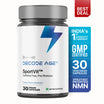Microbiome testing helps you understand the microbes in your gut and how they affect your health. It can reveal imbalances linked to issues like poor digestion, inflammation, or even chronic conditions. Here's what you'll learn:
- Key Metrics: Healthy gut diversity (500-1000 species) and balanced Firmicutes-to-Bacteroidetes (F/B) ratio (1:1 to 3:1) are crucial for gut health.
- Imbalances: Low helpful bacteria (Lactobacillus, Bifidobacterium) or high harmful bacteria (Clostridium) can signal health concerns.
- Fixing Your Gut: Eat prebiotic-rich foods, fermented foods, and stay hydrated. Avoid processed foods and manage stress.
- Tracking Progress: Notice changes like better digestion (2-4 weeks) or reduced inflammation (6-12 weeks) before retesting in 3-6 months.
Your microbiome is unique. Understanding your test results can help personalize your diet, lifestyle, and supplement choices to support optimal gut health. By analyzing your individual microbiome, you can make more informed decisions that enhance digestion, immunity, and overall well-being.
Understanding Your Microbiome Test Results: A Complete Guide
Understanding your microbiome test results is a key step toward unlocking personalized health insights. Your microbiome, which consists of trillions of bacteria and microorganisms residing in your gut, plays a vital role in digestion, immunity, and even mood regulation. With a microbiome test, you can gain a clearer picture of the specific microbes, especially bacteria that inhabit your gut, how they function, and how they might be affecting your overall health. We will walk you through how to interpret your test results, offering practical tips to optimize your diet, lifestyle, and wellness plan based on the unique characteristics of your microbiome.
Reading Your Test Results
Decoding your microbiome test results might feel overwhelming but breaking them into smaller parts makes it easier to grasp. DNA-based testing today offers a detailed look at the microbes, particularly bacteria in your gut and their impact on your health.
Main Test Measurements
Your microbiome test focuses on two key metrics: microbial diversity and population counts. Diversity refers to the variety of microbial species in your gut, while population counts measure the number of each type. A healthy gut usually has a wide range of species.
| Measurement Type | Normal Range | What It Indicates |
|---|---|---|
| Bacterial Diversity | 500-1000 species | Reflects overall gut health and resilience |
| F/B Ratio (Firmicutes-to-Bacteroidetes) | 1:1 to 3:1 | Linked to metabolic health and inflammation |
| Total Bacterial Count | Various | Represents overall bacterial presence |
Understanding Bacterial Balance and Function
Your results highlight both helpful and potentially harmful bacteria. Helpful bacteria like Lactobacillus and Bifidobacterium aid in nutrient absorption, support the immune system, and strengthen the gut barrier. They also produce short-chain fatty acids, which are crucial for gut health [1]. On the other hand, higher levels of bacteria such as Clostridium and Desulfovibrio might signal digestive issues or inflammation.
The test also sheds light on important bacterial functions, such as:
- Processing nutrients
- Regulating inflammation
- Supporting the immune system
- Maintaining the gut barrier
These functional insights reveal how your gut bacteria influence your overall health. Spotting imbalances in these areas can guide you in addressing current concerns and planning for better long-term health.
Steps to Fix Your Gut Health
Once you've reviewed your microbiome test results, making specific changes can help restore balance to your gut. These steps can improve digestion, reduce inflammation, and enhance nutrient absorption, all of which contribute to overall well-being.
Foods That Make a Difference
Your diet plays a major role in shaping your gut microbiome. Prebiotic-rich foods like asparagus and onions help feed beneficial bacteria like Faecalibacterium, encouraging their growth [1]. Here’s how to address common gut imbalances:
| Bacterial Imbalance | Foods to Include | Foods to Avoid |
|---|---|---|
| Low Beneficial Bacteria | Fermented foods (kimchi, kefir), fiber-rich veggies | Processed foods, refined sugars |
| High Firmicutes | Leafy greens, lean proteins, berries | High-fat dairy, red meat |
| Low Diversity | A variety of plant-based foods (aim for 30+ types weekly) | Single-source processed foods |
Small Daily Habits, Big Impact
Stress, poor sleep, and dehydration can harm your gut. Simple lifestyle changes can help maintain a healthier microbiome:
- Get 7-8 hours of sleep each night
- Exercise for at least 150 minutes a week
- Try stress-relief practices like yoga or meditation
- Stay hydrated by drinking 2-3 liters of water daily
Choosing the Right Supplements
Supplements can complement your diet and lifestyle changes, but they should align with your specific needs:
- Probiotics: Pick strains that target the bacteria you're lacking
- Prebiotics: Fiber supplements like inulin to nourish existing good bacteria
- Specialized Support: Supplements designed to reduce inflammation or promote specific beneficial bacteria
Rebalancing your gut takes time and consistency. Regular follow-up testing can help you track your progress and fine-tune your approach.
sbb-itb-55c436e
Tracking Changes and Follow-up Tests
How to Know It's Working
Changes in gut health often show up physically before they appear in test results. Here’s a quick breakdown of what to look for and when:
| Improvement Area | Specific Signs | Typical Timeline |
|---|---|---|
| Digestion | Less bloating, more regular bowel movements, reduced gas | 2-4 weeks |
| Energy & Mood | Higher energy levels, more stable mood | 4-8 weeks |
| Inflammation | Less joint pain, clearer skin | 6-12 weeks |
| Immune Function | Fewer colds, quicker recovery | 8-12 weeks |
Tracking markers like CRP during blood tests can help measure progress [1]. Once physical changes are noticeable, follow-up tests can confirm your results.
Time Between Tests
For most people, follow-up testing 3-6 months after starting interventions is enough to see meaningful shifts [1].
Here’s how often you might need to test based on your situation:
| Health Situation | Recommended Testing Interval | Reason |
|---|---|---|
| Mild Imbalances | Every 6 months | Gives dietary changes time to work |
| Severe Dysbiosis | Every 3-4 months | Requires closer monitoring of bacterial shifts |
| Chronic Conditions | Every 2-3 months | Allows for fine-tuning treatments |
Decode Age tests make it easier to monitor over 30 gut health features, including changes in beneficial bacteria like Bifidobacterium and Lactobacillus. These bacteria are key indicators of progress [1][2].
While gut health improvements can take 6-12 months, many people notice changes much sooner. Use test results to refine your approach and stay motivated as you continue your journey.
Conclusion: Next Steps for Better Gut Health
Microbiome testing is a powerful tool to gain insights into your gut health and guide personalized strategies for improving digestion, immune function, and overall well-being. By understanding the balance of microbes in your gut, you can make informed decisions about diet, lifestyle, and supplementation that support a healthier microbiome. Remember, the journey to optimal gut health takes time and consistency. With regular follow-up tests, you can track your progress and make adjustments as needed, ensuring lasting improvements.
Taking control of your gut health is an investment in your long-term wellness, and microbiome testing provides the roadmap for a more informed and empowered approach to health.
FAQs
How often should I get microbiome testing?
For most people, testing every 3-6 months is recommended. If you have mild imbalances, testing every 6 months should be sufficient. For more severe issues or chronic conditions, more frequent follow-ups (every 2-4 months) may be necessary to track bacterial shifts and adjust treatments accordingly.
What do I do if my microbiome test shows imbalances?
If your results indicate an imbalance, start by making dietary changes that encourage the growth of beneficial bacteria, such as incorporating prebiotics, fermented foods, and fiber-rich vegetables. Lifestyle changes like reducing stress, staying hydrated, and getting enough sleep are also crucial. In some cases, supplements like probiotics or prebiotics may be recommended to support gut health.
How long does it take to see results after improving my gut health?
Visible changes can vary depending on the person, but improvements in digestion may be noticeable within 2-4 weeks, while changes in inflammation or immune function could take 6-12 weeks. Full progress, especially in chronic conditions, might take 6-12 months, though many people feel improvements sooner.
Can microbiome test help with conditions like IBS or autoimmune diseases?
Yes, microbiome testing can help identify gut imbalances that may contribute to conditions like Irritable Bowel Syndrome (IBS) or autoimmune diseases. By understanding your unique microbiome, you can make targeted changes to your diet and lifestyle that may improve symptoms and overall health.
Can I use microbiome testing to help with weight loss?
Microbiome testing can provide valuable insights into the types of bacteria that may be influencing your metabolism and weight. By addressing imbalances, such as high Firmicutes levels (associated with obesity), you can make dietary adjustments that promote a healthier weight. However, it’s important to combine microbiome insights with a balanced approach to diet and exercise.
Is microbiome testing a one-time thing, or should I test regularly?
Microbiome testing is not a one-time process. As your microbiome can change based on factors like diet, lifestyle, and stress, regular testing allows you to track shifts and make ongoing adjustments for better gut health. Testing every 3-6 months is recommended to monitor progress and fine-tune your approach.
Are microbiome tests accurate?
Microbiome tests are based on DNA analysis of microbial samples, which provides a detailed snapshot of your gut’s microbial composition. While they offer valuable insights, they are still evolving, and interpretations may vary. It’s best to consult with a healthcare professional to fully understand your results and make informed decisions.






















